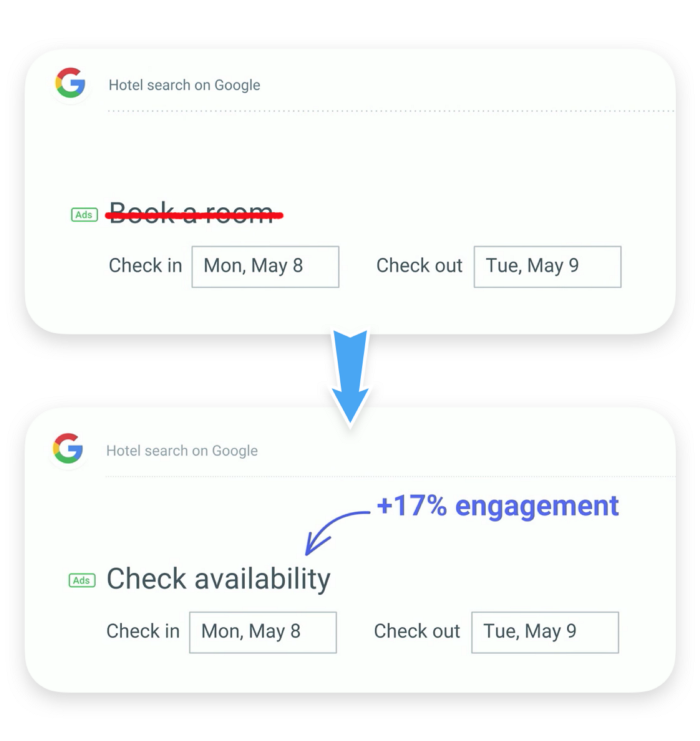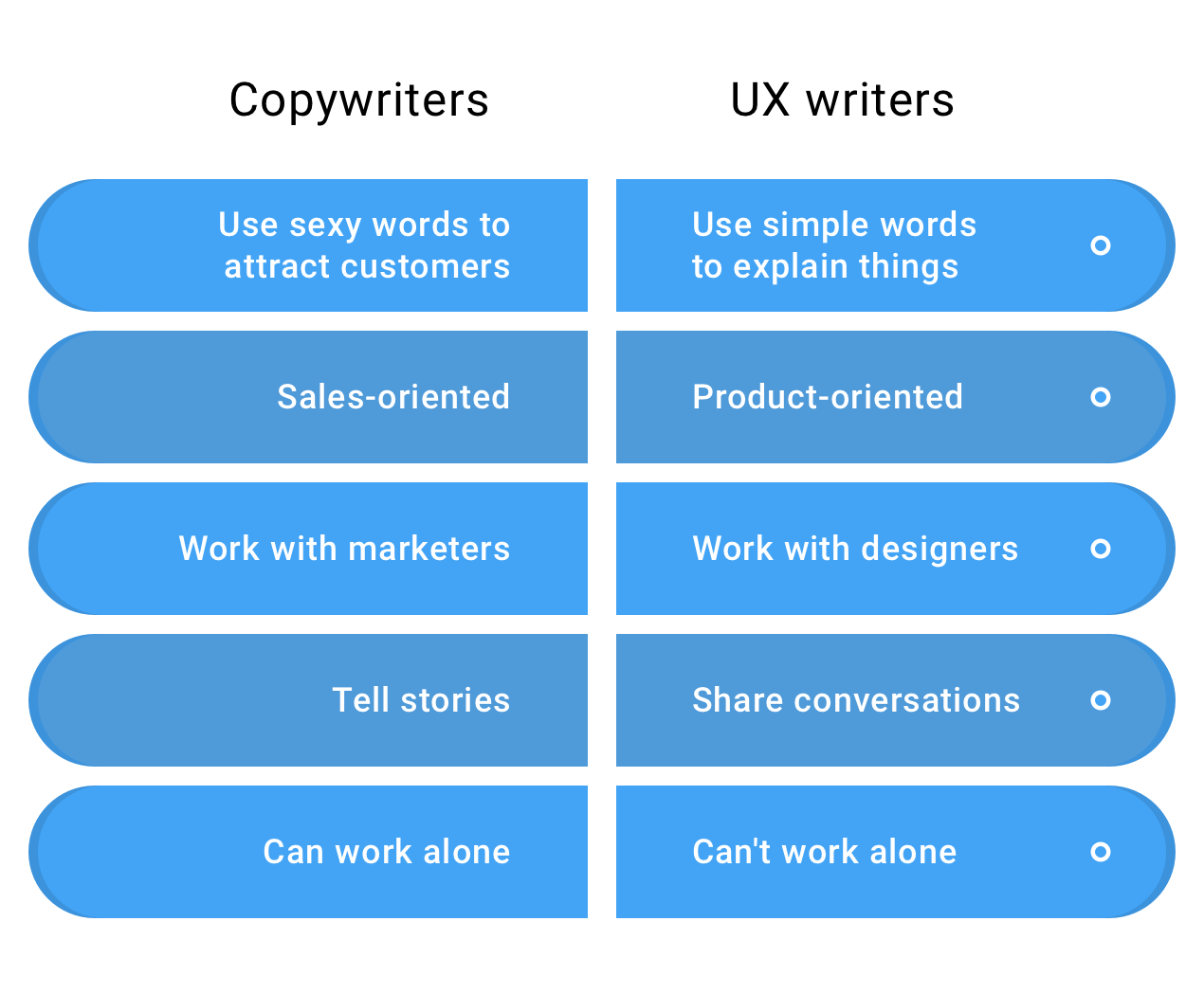As a writer who studied advertising and then went on to work for marketing agencies, much of my career has been spent copywriting. It’s what I was taught and had experience in – what I knew. Imagine my surprise when I was told that I’d be working on UX for clients in the near future.
On what?
I buckled down. A billion tabs open. Notes sprawling the desk. Ink-stained hands. (Yes, I have a laptop, but I like pens, okay?) It’s when I first discovered the term UX writing.
If you’ve heard about UX writing, as a writer, you’re probably wondering how it relates to your profession. Can you do it? Should you do it? Is it something new or another buzzword?
As a business owner, you’re probably wondering if you need one. “Doesn’t my copywriter suffice?”
The profession of UX is a newer one, and it’s growing. Major tech companies like Google, Amazon and Microsoft all have teams of UX writers. But, what are these people doing?
What IS a UX writer? And what makes UX writing different from copywriting?
Well, let me tell you.
What Is UX Writing?
UX is short for user experience and is a fundamental part of UX design, from which UX writing stemmed. The essence of user experience design is that it’s centered on creating a great user experience. UX writing does the same – but for writing.
It’s worth noting that UX designers and writers work together to create a great user experience, and they don’t replace one another. Designers design and writers write, but they do it united to optimize the message behind the other.
A UX writer’s job is to write copy for the user interface (UI) of a product to help guide users through that product. As a result, UX writers are most often responsible for the copy users interact with while using a product, including:
- Buttons
- Error messages
- Controls
- Notifications
- Instructions
- Onboarding sequences
- Form fields
- Loading screen messages
- Chatbots
A UX writer is sometimes called a content designer or content strategist. Content design is an older term, while content strategy has picked up other meanings and is no longer accurate to describe a UX writer’s role.
Part of the growth of UX writing in recent years is due to how well it works.
One Google study looked into how people used their hotel search feature. In analyzing the customer journey, they found that the UX copy “Book a room” was intimidating and led users to feel like they were making a commitment. So, they switched it to “Check availability” and watched as user engagement increased by 17%. That’s the power of good UX writing.

Source: UX Collective.
What Is Copywriting?
You’re probably more familiar with copywriting as it has been around since the first written work was published to promote prayer.
Copywriting is any copy that’s written to drive sales, whether that’s directly (an ad) or indirectly (business blogging). Examples of copywriting include:
- Landing pages
- Email newsletters
- Product descriptions
- Blog posts
- Social posts
- Print ads
- Radio jingles
- Slogans
- White papers
Different types of copywriting call for special considerations and needs. Copy on a billboard needs to be short and memorable, while the art of writing website content is a beast of its own. But it’s all meant to draw attention, inform, leave a lasting brand impression and lead to a desired action or emotion.
So, What’s the Difference?
I won’t lie. When I first heard of UX writing, I was a bit stumped. I thought, isn’t that what I’ve been doing all along?
Then I read an article by Chris Cooper, the founder of Real Good Writing, where he put my feelings into words:
“I never thought of myself as a UX writer because, I guess, I never knew there needed to be such a distinction. As far as I’m concerned, any copywriter worth his salt needs to account for customer interactions throughout the experience, whether that’s on a website, within an application, or anywhere else. I mean, what the hell are you writing for if not to improve the customer’s experience?”
Essentially, copywriting is the thing – the writing itself. Our goal is to make users feel something and encourage them to complete a task; UX is the thought process that makes it effective.
But this is semantics. There are differences because the profession of UX writing isn’t just writing that follows UX.
What People Claim the Differences Are
There are many claims about the differences between copywriting and UX writing.
 Source: UX Collective.
Source: UX Collective.
The problem is that many of these claims are too decisive for how much generalizing they do, so they can feel inaccurate to the people in the professions.
Not all the differences between UX writing and copywriting are as black and white as they are made out to be. Let’s look at some of these differences and the gray areas involved.
1. Copywriting helps the business. UX writing helps the customers.
The gray area: Good copywriting benefits the customer as well. UX writing also helps the business; it’s written to help users complete tasks that either benefit the business or increase user satisfaction, so they stick with the business.
2. UX writing is for existing users, not customers.
The gray area: What about websites where UX writers help guide customers? What about apps with in-app purchases?
3. UX writing is technical, not creative.
The gray area: UX writers should be familiar with the technical end of things to translate for the user, but their role is to be empathetic to the user experience, and they still want the user to enjoy themselves. UX writers are also required to creatively combine context and brand voice. A user-friendly error message might take on a creative flair, depending on the brand and context. When the message isn’t fun, it takes a creative mind to get it across in the best way to amplify the user experience.
4. UX writers don’t tell stories.
The gray area: UX writers use UX storytelling to reflect user journeys and problems to reach a better understanding and provide the best solution. If the writer is creative enough, they can also tell stories while directing and encouraging users.
5. UX writing is microcopy.
The gray area: Copywriting also uses microcopy in headers and CTAs. Microcopy is shorter copy written with very few words, and both copywriters and UX writers end up working with some of these areas.
6. Copywriting is about marketing, not user experience.
The gray area: Good copywriters always consider the audience’s experience and write to meet their needs and improve their emotional state. For years, copywriting has increasingly emphasized empathy, benefiting customers and solving their problems.
7. Copywriters try to make readers take a specific action.
The gray area: UX writing aims to help users take the actions required to complete a task. UX writers still work to improve conversion goals, like in the Google example earlier. It’s why both copywriters and UX writers conduct A/B testing.
8. Copywriters work alone, and UX writers work in teams.
The gray area: UX writers engage with more teams and do so more often, but copywriters do not and should not work alone. Good copy comes from understanding strategy, goals, the products you’re writing for, and the designs your copy will work with; this all requires interacting with other departments.
The Real Difference – From a Writer
Good UX writing and copywriting have a lot of the same rules and challenges. Both require a grasp of people’s needs, feelings and the questions they’re asking in their heads so that they can reduce friction and build trust. A UX writer trying to write an effective button that guides the user to click is not unlike a copywriter working on a clear, descriptive CTA that gets the reader to act.
With slight adjustments in timelines, the process of UX writing and copywriting are similar as well as they both require research, understanding the product and audience, writing for the audience, making it easy to understand and enjoyable, editing, testing and continually improving. UX writing is even sometimes called “copywriting in UX design.”
But in a professional sense, it is necessary to distinguish UX writers and copywriters.
Why?
Because in the field, the terms describe two different jobs – even if the sentiment is similar. And that’s where the main difference lies.
Copywriting = marketing materials
UX Writing = digital product use
The main difference between UX writing and copywriting is that when people reference UX writing, they’re talking about writing for a digital product. The term can apply to physical products, but in most use cases, UX writing is writing to help users use digital products.
Since UX writers help create the product, they usually come in sooner to work with stakeholders and product teams. Tiffany Lee, a UX writer for Google, describes her role:
“I was elated to learn I could actually help build products… I’m constantly interfacing with designers, product managers, engineers, other writers, and researchers before I can type a single word.”
On the other hand, copywriting refers to marketing-related materials and isn’t limited to the digital realm in any way. It’s not uncommon for copywriters to come in after the product is created and occasionally suggest adjustments to optimize copy impact.
And copywriting isn’t always for “users” of a product; the viewer may be a user or target audience member. Regardless of who the viewer is, good copy does consider their experience.
These differences mean that the roles also care about different types of data (sometimes). A copywriter who writes a blog might care more about impressions, time spent and bounces. A UX writer who writes for a mobile app might care more about daily active usage, ease of use, goal completions and user satisfaction. Of course, the line blurs when it comes to writing for websites as they’ll both care about clicks and goal completions.
UX Copywriting: How About Both?
UX writing and copywriting are very similar. Often, the more similar they get, the better they are, taking the best of both worlds. In a few instances, the roles of the two overlap a bit. And in a small business, you may even find yourself doing both.
Many of these writers have taken to calling themselves UX copywriters: writers who write to represent a company with UX as the priority and who work to guide users in a way that aligns with user and company goals.
As a newer field, many UX writers were copywriters first. But, to be a UX writer, it helps to have knowledge in design and the technologies you’re writing for.
And if you run a larger company, or your service is an app or software, it’s best to hire copywriters and UX writers to handle your marketing and product writing, respectively. They are still two different roles with unique strengths.
Have a product in need of a UX makeover or a website in need of better copy? Reach out to the experts at Boldist.


